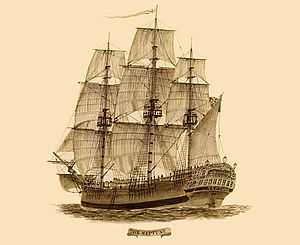Neptune (ship)
 Neptune | |
| Career (Great Britain) | |
|---|---|
| Name: | Neptune |
| Launched: | 1779, River Thames |
| General characteristics | |
| Type: | Barque |
| Tons burthen: | 809 |
| Sail plan: | Ship rig |
Neptune was one of the notorious Second Fleet ships to Port Jackson. Built in the River Thames in 1779, at 809 tons she was the largest ship of the fleet. In company with Surprize and Scarborough she sailed from England with 421 male and 78 female convicts on 19 January 1790. Her master was Donald Traill and surgeon was William Gray. She arrived at the Cape of Good Hope on 13 April 1790, and spent sixteen days there, taking on provisions, and twelve male convicts from HMS Guardian which had been wrecked after striking an iceberg. She and Scarborough were parted from Surprize in heavy weather and arrived at Port Jackson on 28 June 160 days out from England. During the voyage 158 convicts died (31%) and 269 (53%) were sick when landed.
The treatment of convicts aboard the Neptune was unquestionably the most horrific in the history of transportation to Australia[citation needed]. Convicts suspected of petty theft were flogged to death; most were kept chained below decks for the duration of the voyage; scurvy and other diseases were endemic; and the food rations were pitiful.
Upon their return to England, the Master, Donald Traill, and Chief Mate, William Ellerington, were privately prosecuted for the murder of an unnamed convict, along with a seaman named Andrew Anderson and a cook named John Joseph. After a trial lasting three hours before Sir James Marriott in the Admiralty Court, the jury acquitted both men on all charges "without troubling the Judge to sum up the evidence". There were no public prosecutions.
Amongst the arrivals on this voyage was D'Arcy Wentworth. John Macarthur, his wife Elizabeth, and their son Edward Macarthur left England on Neptune but transferred to Scarborough after a quarrel with the captain. A photograph of Edward Macarthur exists, which can be seen here , and is the only known photo of a passenger on Neptune.
Sarah Cobcroft (née Smith), de facto of convict John Cobcroft, a mid wife and later pioneer farmer of Wilberforce, New South Wales also arrived aboard the Neptune.
Details of the convicts who arrived on Neptune are given here:
Further reading
- Bateson, Charles, The Convict Ships, 1787-1868, Sydney, 1974.
- Admiralty Proceedings on the Sessions held 7 and 8 June 1792 before Sir James Marriott and others, Trials of Kimber, Traill, Ellerington and Hindmarch for murder and Berry and Slack for piracy, London 1792
- Emma Christopher, Cassandra Pybus, Marcus Buford Rediker, Marcus Rediker (eds.), Many Middle Passages: Forced Migration and the Making of the Modern World, Berkeley: University of California Press, 2007, chapter 6 by Emma Christopher, "Slave Traders, Convict Transportation, and the Abolitionists".
- Neptune Convict Ship, voyages to Australia Sailed on December, 1817; Sailed on 18 March 1820; Sailed on 4 October 1837; Sailed on 18 April 1849 http://www.convictrecords.com.au/ships/neptune